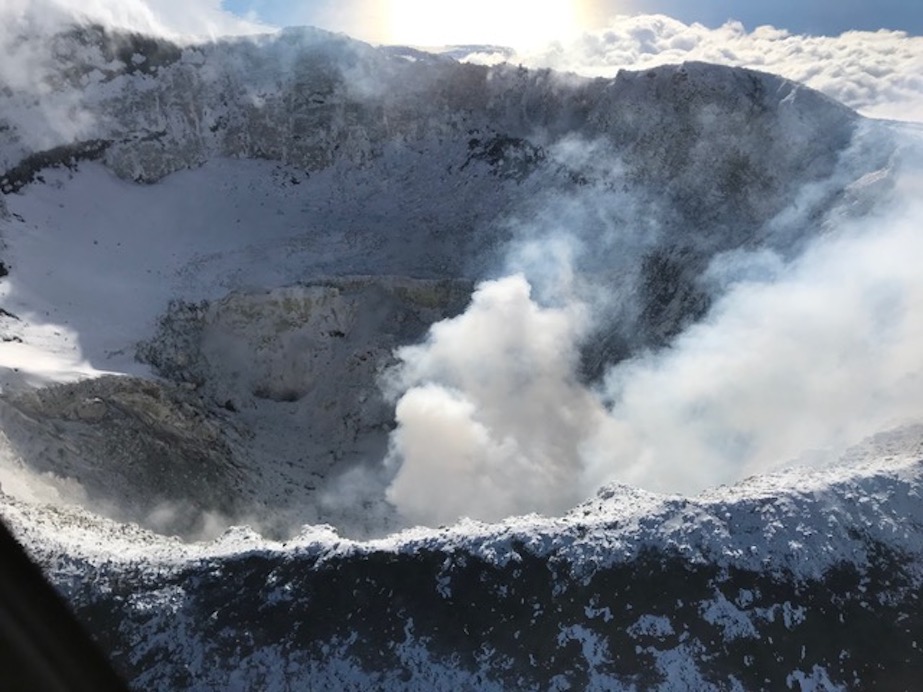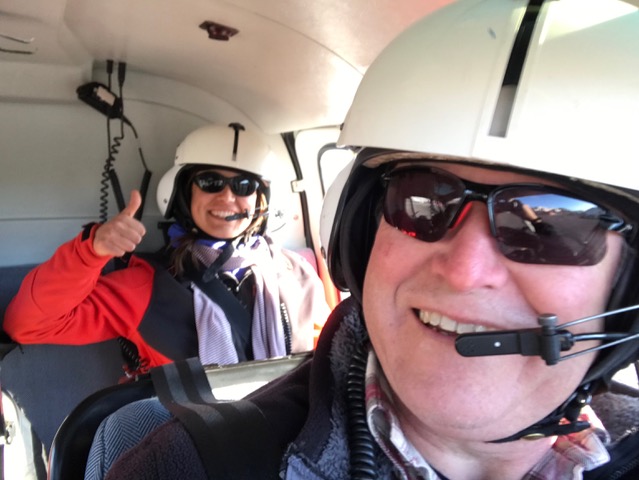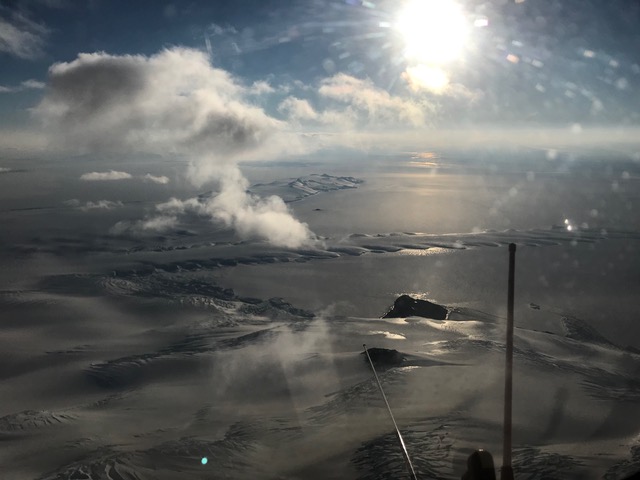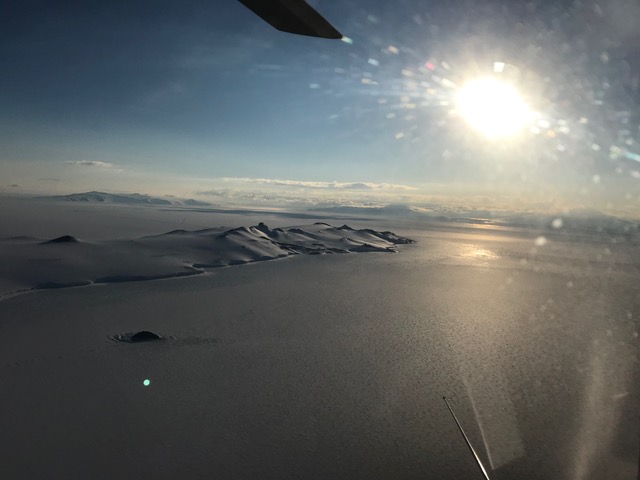
McMurdo is in full swing, and the five MCM helicopters are ready for action. For you helicopter fans - that is three Bell 212s, and two A-Stars - quite an amazing fleet of helicopter power. And there are fabulously experienced pilots for all of them (the pilots have to be about the most chill dudes you will ever meet). These pilots and their “load techs” (the ones who load the gear on the helicopters and ensure that everything is balanced) do an amazing job of flying us scientists all over the place and keeping us safe, despite our lack of experience working in and around helicopters. Here is a photo with all the helicopters on the ground that I took on a Sunday.
 After several days of trying, and failing, to get to the top of Erebus, I have started to think of Erebus as the 'bad boy”. As in, “that bad boy just isn’t going to relent and let us fly up there”. It seems like Erebus is only clear and sunny on the days the helicopters don’t fly. On Monday we are on the helicopter night schedule again. Our third try. And sure enough, on Monday the weather sucks. It snows all day at McMurdo. I work on the computer all day, trying to catch up a bit on my “back home” job now that everyone is starting to return to work after taking time off during the holidays. It is a bit like re-entry for me, as my "real job" starts to tug at my attention and my time in Antarctica is winding down.
After several days of trying, and failing, to get to the top of Erebus, I have started to think of Erebus as the 'bad boy”. As in, “that bad boy just isn’t going to relent and let us fly up there”. It seems like Erebus is only clear and sunny on the days the helicopters don’t fly. On Monday we are on the helicopter night schedule again. Our third try. And sure enough, on Monday the weather sucks. It snows all day at McMurdo. I work on the computer all day, trying to catch up a bit on my “back home” job now that everyone is starting to return to work after taking time off during the holidays. It is a bit like re-entry for me, as my "real job" starts to tug at my attention and my time in Antarctica is winding down.
Tuesday morning starts out cloudy. It doesn’t look much like flying weather. We are on the helicopter night schedule again. But lo and behold, the skies gradually clear during the day. Late in the day the helicopter scheduler says “you're on”. Woo hoo! We have had the batteries, tools, equipment, electronics and everything else fully packed for six days now. We are so (!) ready to fly up and work on the station at site CONZ (“Cone Z”). After an afternoon of excited anticipation, expecting a last minute cancellation e-mail at any minute, we are finally “on”. The bad boy has relented.
At 6:30 PM we show up at the “helo pad” and start to do final checkout. Every last bit of gear, including ourselves, is carefully weighed and tallied. Our 640 pounds of replacement batteries comprises most of the load on a Bell 212. We are flying to something around 11,000 feet, so the helicopters will be near their load limits.
By the way, remember that post a month ago when I talked about all my “happy little batteries”? Charging, testing, and wiring those batteries was my first task when I arrived in Antarctica. Well here they are. My little charges are about to get their moment of glory when they are installed in each of the four seismic stations on Erebus (eight at each station). In addition to batteries, we have a replacement Q330 that is programmed with the correct firmware for the GPS week rollover. We have a replacement baler. We have a new power controller with the latest firmware. We have spare battery wiring harnesses, connectors, adaptors, and all the tools we think we might need. Yet we are still not taking all the tools and spares we would really like to take, as we need to stay within our weight constraints for the helicopter.
We’ll have four hours of ground time at the CONZ site. Kirsten is the team lead and we have talked through the choreography of every step we will execute at the station. We have discussed who will do what, when it will be done, and by which person. We have discussed how we will label the equipment we remove, so it will not be confused with the equipment we are installing. We have discussed the tests we will run. We have a four page checklist that we will execute. We have visualized every step.
Finally, finally, finally, after the planning, the preparing, and six days of waiting, we are on our way. Pure joy is on our faces as we finally lift off and start flying towards Erebus.
 As we circle around the volcano towards our landing site, we get a direct look into the steaming caldera.
As we circle around the volcano towards our landing site, we get a direct look into the steaming caldera.
 Our two helicopters land on Erebus. The conditions are absolutely perfect. Not a breath of wind. Perfectly clear sky with -20 degrees C temperatures. The top of Erebus can be brutal. But Erebus has relented and given us a break. With both helicopters on the ground we get to work. The orange box holds all of the station batteries and electronics. The seismometer is buried under the snow.
Our two helicopters land on Erebus. The conditions are absolutely perfect. Not a breath of wind. Perfectly clear sky with -20 degrees C temperatures. The top of Erebus can be brutal. But Erebus has relented and given us a break. With both helicopters on the ground we get to work. The orange box holds all of the station batteries and electronics. The seismometer is buried under the snow.
 Kirsten sets to work with her laptop to interrogate the station and log every single aspect of the station configuration before we start touching anything. I set to work clearing snow, moving batteries, inspecting the solar panels for signs of damage, etc.
Kirsten sets to work with her laptop to interrogate the station and log every single aspect of the station configuration before we start touching anything. I set to work clearing snow, moving batteries, inspecting the solar panels for signs of damage, etc.
 After logging all of the station configuration to the laptop and giving the shutdown commands, we open the box. All the station electronics are moved to the top of the box so we can inspect them and start swapping out batteries and units.
After logging all of the station configuration to the laptop and giving the shutdown commands, we open the box. All the station electronics are moved to the top of the box so we can inspect them and start swapping out batteries and units.
 About two hours later we are done. The whole station service process went without a hitch and we are super happy with how this process turned out. We repack everything and we still have some leftover ground time to walk the surrounding area to evaluate rock conditions for making a new and improved posthole sensor installation next year. From one of these locations I take a picture looking out towards the boundary between the sea ice and the open ocean.
About two hours later we are done. The whole station service process went without a hitch and we are super happy with how this process turned out. We repack everything and we still have some leftover ground time to walk the surrounding area to evaluate rock conditions for making a new and improved posthole sensor installation next year. From one of these locations I take a picture looking out towards the boundary between the sea ice and the open ocean.
 After a bit of time spent exploring near the summit of Erebus, it is time to head down. The helicopter quickly drops down the flank of 12,000 ft Mt Erebus. In this photo you can see the “Erebus ice tongue” - the end of the Erebus glacier pushing right out into the sea ice. It looks sort of like a boat launching ramp in a lake. McMurdo is at the tip of the peninsula in the distance, towards the sun.
After a bit of time spent exploring near the summit of Erebus, it is time to head down. The helicopter quickly drops down the flank of 12,000 ft Mt Erebus. In this photo you can see the “Erebus ice tongue” - the end of the Erebus glacier pushing right out into the sea ice. It looks sort of like a boat launching ramp in a lake. McMurdo is at the tip of the peninsula in the distance, towards the sun.
 It is a little past midnight and we are flying towards McMurdo, located at the far end of this peninsula. After six days of waiting we finally have Erebus station number two done. My colleagues will finish the last two sites without me - the interestingly named sites Nausea Knob and Ice Z.
It is a little past midnight and we are flying towards McMurdo, located at the far end of this peninsula. After six days of waiting we finally have Erebus station number two done. My colleagues will finish the last two sites without me - the interestingly named sites Nausea Knob and Ice Z.
The next day I spend most of my time on the phone (not quite the adrenaline level of helicoptering around Erebus) in meetings back in Washington. Then it is time to pack my clothes and do the “bag drag” - head to building 140, drag your bags up to the scale, and weigh every last piece of baggage and carry on, yourself included, for the LC-130 Hercules flight back to Christchurch tomorrow.
 Have I really been here just shy of six weeks? The trip has gone by in a flash. I cannot even begin to describe all that I have learned - about science, science programs, people, places, technology, geography, and even my own field of seismology. I have so much new knowledge to apply when I get back to my "real job". This was truly the experience of a lifetime.
Have I really been here just shy of six weeks? The trip has gone by in a flash. I cannot even begin to describe all that I have learned - about science, science programs, people, places, technology, geography, and even my own field of seismology. I have so much new knowledge to apply when I get back to my "real job". This was truly the experience of a lifetime.